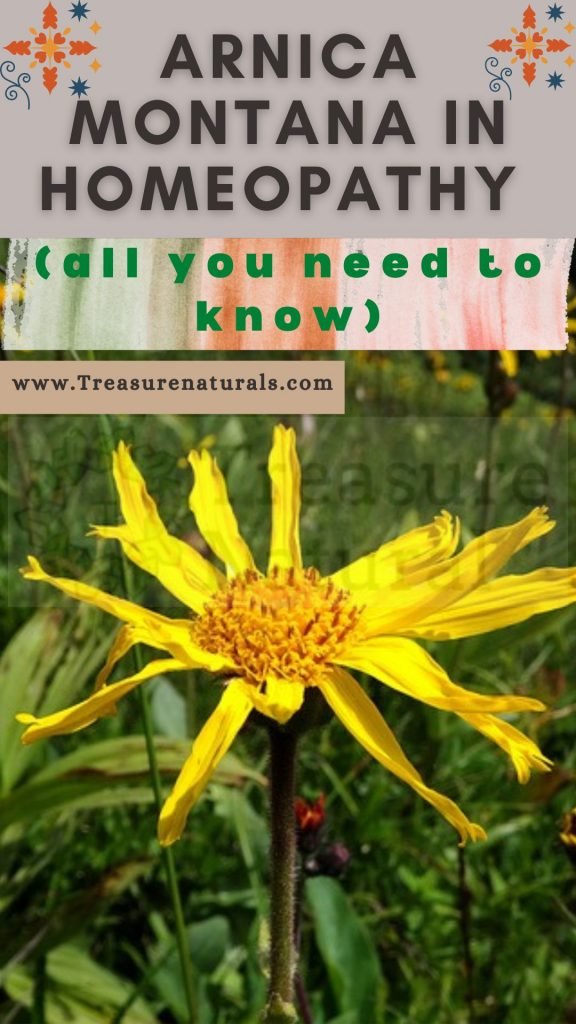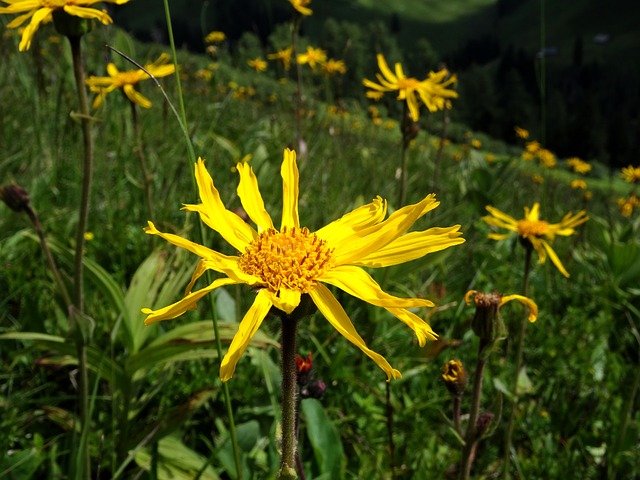
Arnica is a natural remedy used in herbal medicine and homeopathy for the treatment of trauma, bruises and muscle pain.
The Arnica is a homeopathic remedy that is convenient for sports. Thanks to its properties it is suitable for the treatment of physical and psychological trauma, inflammation and injuries. Let’s find out better.
Description of the plant
The Arnica ( Arnica montana ) is a perennial herb belonging to the family Asteraceae that grows wild on the Alps and the Apennines at altitudes above 2000 meters.
The plant has a rosette of whole and lanceolate basal leaves from which an inflorescent scape develops in summer. The flowers are flower heads consisting of yellow ligulate female flowers and central tubular hermaphroditic flowers, while the fruits are brown and shaggy.
Arnica was first described in the 16th century by the German physician and naturalist Theodorus Jacobus Von Bergzabern (1520–1590), who gave it its name.
It is commonly called ” sneeze ” due to the ability of its smell to cause sneezing. From its leaves we get the so-called ” mountain tobacco “, used by mountain populations for pipes and as snuff.
The plant has anti-inflammatory and antibacterial properties and is used as a remedy in phytotherapy and homeopathy. The drug consists of flower heads that contain sesquiterpene lactones and their esters, flavonoids, fatty acids and essential oil. The homeopathic remedy Arnica montana is obtained from the mother tincture of its flowers, suitably diluted.
When using Arnica montana
The Arnica is traditionally used topically in case of bruises, sprains, bruises and localized muscle pain. For this purpose, ointments, gels and ointments containing arnica extracts in dosages from 5 to 25% are used in phytotherapy.
In homeopathy it is instead the traumatic remedy par excellence and corresponds to the effects due to recent and past traumas, both physical and psychological. Homeopathy also uses arnica for cardiovascular, respiratory, urogenital disorders, eye inflammation and fever.
However, it should be emphasized that studies on the effectiveness of arnica are scarce and its use is almost exclusively based on tradition; as far as homeopathic use is concerned, this has no scientific evidence to date.
Herbal use of arnica
In herbal medicine and phytotherapy, arnica is used in the form of gels, ointments, ointments, oleolites and other topical preparations for:
- Hematomas, edema, fractures, bruises and sprains, inflammation, muscle tears, dislocations and rheumatism;
- post surgical pain;
- gingivitis and inflammation of the oral cavity;
- skin problems, boils, acne;
- insect bites.
Arnica-based remedies should only be used externally on intact skin free from lesions and wounds, in adults and adolescents over 12 years of age.
If your symptoms do not improve within two to three days, you should see your doctor. In susceptible individuals, the use of arnica can give rise to hypersensitivity reactions with itching, swelling and redness of the skin. It is also not recommended to use arnica-based products during pregnancy and breastfeeding.
Doses and administration in homeopathy

- In cases of physical or psychological trauma, if the disorders are due to a recent trauma, homeopathy uses arnica at low dilutions such as, for example, the 4CH dilution at a dose of 4 granules 3 times a day. The treatment is completed with the use of the ointment for local applications.
- If the disturbances are due to a remote trauma, a higher dilution such as 15CH or 30CH at a dose of 15 drops per day is preferred .
- If it is a psychological trauma, the 15CH dilution is used in a single dose of 5 granules, which is repeated after 10 – 15 days.
In homeopathy, arnica is also used in case of disorders of the cardiovascular system, skin and subcutaneous tissue and in cases of rheumatism, at the 4CH dilution, 3 – 4 granules or 10 – 15 drops, 3 – 4 times a day. It is completed with the ointment for external use.
For urogenital dysfunctions, eye disorders, infectious and feverish states, homeopathic medicine indicates a 3CH dilution, 2 – 3 granules or 5 – 10 drops, 3 – 6 times a day. In cases of digestive system disorders, in the case of motion sickness or sea sickness of adults, dilution 3CH, 10 drops every hour; in other situations, dilution 4CH, 3 – 4 granules or 10 drops, 3 times a day.
In cases of respiratory system dysfunction, dilution 4CH, 2 – 3 granules or 5 drops every 2 – 3 hours.






